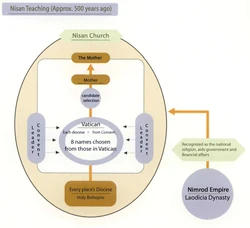| This article pertains to Xenogears: the sub-database of Xenosaga Wiki. |
Nimrod was a country that existed hundreds of years before Xenogears. In the time of Xenogears, it no longer exists, and is mainly mentioned only in Perfect Works.
History
Founded in 9301, Nimrod started as a small country that was located near the present day Aveh-Kislev border. By the time of Emperor Kusel Laodicia's reign in 9440, Nimrod had grown exponentially, making it a formidable nation second only to Shevat at the time.[1]
The Laodicia-Nisan Conflict
In 9453, political strife between various countries on the surface prevailed. Wanting to bolster his country's authority and domain, Kusel Laodicia seized upon the widespread popularity of the Nisan Sect by recognizing it as Nimrod's state religion.[1] With Nimrod's recognition came economical aid, allowing the Nisan Sect to expand its reach even further as a religion.[2]

In time, Kusel was granted the power to ordain bishops in each diocese, which were responsible for offering administrative support to the central structures of the Nisan Sect.[2][3] In 9487, wanting to further grow his hold on the Nisan Sect, Kusel conspired to have the next Holy Mother be a supporter of his dynasty. To this end, he requested the central authorities of the Nisan Church for the authority to directly select the next Holy Mother.[3]
Nisan strongly objected to Kusel's request, wanting to keep the traditional process of electing a Holy Mother through the support of various Cardinals. In order to get around this, Nimrod instead used an indirect route by trying appease each diocese's bishop, in order to persuade them to Kusel's cause.[3]
In order to keep Nimrod from taking complete control of the selection process, the Cardinals rearranged Nisan's entire power structure of Nisan, and appointed their most prominent member, Penuel, as the First Prelate. With this, the power to ordain the next Holy Mother was in Penuel's hands. After Nimrod's attempts to influence the newly appointed Penuel are thwarted by the intervention of other Cardinals, Kusel's plans were temporarily halted.[3]
Things came to a head when Penuel elected his thirteen year old adopted daughter, Sophia, as candidate for Holy Mother.[1][2][4] While Nimrod's influence had been stopped, the power play between the factions of various candidates was still a contentious one, regardless of the wishes of the candidates drawn into the selection process.[2][4] On top of this, many in the Church objected to the select of Penuel as First Prelate.[3]
Frustrated by the cardinals' opposition, Kusel plotted the assassination of Penuel and Sophia. Hiring a squad of mercenaries, he elected Karellen, who was known for his military prowess as well as his cold-hearted demeanor, as its leader.[3][5] Disguising themselves as part of the anti-Penuel faction, Karellen's group led an attack on a monastery Penuel was visiting, and took advantage of the chaos to carry out their orders, leading to the deaths of over half the Penuel Convent, including Penuel himself.[4] Instead of finishing his next target, Karellen, charmed by Sophia's smile, disappeared with her.[1] Penuel's niece, Sieglinde, similarly went missing.[3]
In the wake of the attack, the Laodicia Dynasty suddenly collapsed in 9490, with Kusel Laodicia being murdered that same year.[6] The Nisan Sect similarly fell, undergoing a schism between the remains of the Penuel faction and the remaining dioceses. The Nisan religion would not begin its gradual recovery until seven years later, with the reappearance of Karellen, Sophia, and Sieglinde.[3]
Etymology
Nimrod, king of Shinar, was, according to the Book of Genesis and Books of Chronicles, the son of Cush, the great-grandson of Noah. The Bible states that he was "a mighty hunter before the Lord [and] .... began to be mighty in the earth". Extra-biblical traditions associating him with the Tower of Babel led to his reputation as a king who was rebellious against God.